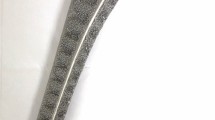Summary
Mid- and long term stability is still the major challenge in total hip replacement (THR). A consecutive series of cemented 250 cases and of uncemented 250 cases was analyzed in a prospective follow-up study. The femoral component of the BiCONTACT hip stem system with the same design for cemented and uncemented implantation was used. While the cemented stems had a smooth surface, the cementless implants were proximally coated with a microporous titanium plasmaspray (Plasmapore®). Follow-up time averaged 7 years for cemented and 6.5 years for uncemented THRs. Follow-up rate was 88.7% in cases treated with cemented stems and 93.1% in cases treated with an uncemented stem. The rate of aseptic loosening was 1.2% for the cemented version and 0.4% for the uncemented one. Radiological loosening could be observed in another 1.2% of the cemented stems but was not found in the uncemented cases. Our data suggest excellent midterm stability of both the cemented and the uncemented version of the BiCONTACT hip stem system. Early aseptic loosening especially of the cemented titanium alloy straight stem has not occurred in our series as reported recently. The prosthesis design and follow-up time may therefore play an important role. The long-term results for both cemented and uncemented BiCONTACT prostheses of our series are still to be evaluated.
Similar content being viewed by others
References
Alsema R, Deutman R, Mulder TJ (1994) Stanmore total hip replacement. A 15- to 16-year clinical and radiographic follow-up. J Bone Joint Surg Br 76: 240–244
Ballard WT, Callaghan JJ, Sullivan PM, Johnston RC (1994) The results of improved cementing techniques for total hip arthroplasty in patients less than fifty years old. A ten-year follow-up study [see comments]. J Bone Joint Surg Am 76: 959–964
Beckenbaugh RD, Ilstrup DM (1978) Total hip arthroplasty. A review of three hundred and thirty-three cases with long follow-up. J Bone Joint Surg 60-A: 306–313
Bobyn JD, Pilliar RM, Cameron HU, Weatherly GC (1980) The optimum pore size for the fixation of porous-surfaced metal implants by the ingrowth of bone. Clin Orthop 150: 263–270
Britton AR, Murray DW, Bulstrode CJ, McPherson K, Denham R (1997) Pain levels after total hip replacement. J Bone Joint Surg 79-B: 93–98
Bryant MJ, Kernohan WG, Nixon JR, Mollan RAB (1993) A statistical analysis of hip scores. J Bone Joint Surg 75-B: 705–709
Dorr LD, Luckett M, Conaty JP (1990) Total hip arthroplasty in patients younger than 45 years. Clin Orthop 260: 215–219
Gorab RS, Covino BM, Borden LS (1993) The rationale for cementless revision total hip replacement with contemporary technology. Orthop Clin North Am 24: 627–633
Gruen TA, McNeice GM, Amstutz HC (1979) “Modes of failure” of cemented stem-type femoral components. Clin Orthop 141: 17–27
Harris WH, McGann WA (1986) Loosening of the femoral component after use of the medullary-plug cementing technique. Follow-up note with a minimum five-year follow-up. J Bone Joint Surg [Am] 68-A: 1064–1066
Malchau H, Herberts P, Ahnfelt L (1993) Prognosis of total hip replacement in Sweden. Follow-up of 92,675 operations performed 1978–1990. Acta Orthop Scand 64: 497–506
Martell JM, Pierson RH, Jacobs JJ, Rosenberg AG, Maley M, Galante JO (1993) Primary total hip reconstruction with a titanium fiber-coated prosthesis inserted without cement. J Bone Joint Surg [Am] 75-A: 554–571
Murray DW, Carr AJ, Bulstrode CJ (1995) Which primary total hip replacement? J Bone Joint Surg [Br] 77-B: 520–527
Murray DW, Britton AR, Bulstrode CJ (1997) Loss to follow-up matters. J Bone Joint Surg [Br] 79-B: 254–257
Neumann L, Freund KG, Sorenson KH (1994) Long-term results of Charnley total hip replacement. Review of 92 patients at 15 to 20 years. J Bone Joint Surg [Br] 76-B: 245–251
Oishi CS, Walker RH, Colwell CWJ (1994) The femoral component in total hip arthroplasty. Six to eight-year follow-up of one hundred consecutive patients after use of a third-generation cementing technique. J Bone Joint Surg [Am] 76: 1130–1136
Osorovitz P, Goutallier D (1994) Résultats clinques et radiographiques d'une série continue de 124 prothèses totales de hanche type Céraver-Ostéal avec courbe de survie à 9 ans. Rev Chir Orthop 80: 305–315
Owen TD, Moran CG, Smith SR, Pinder IM (1994) Results of uncemented porous-coated anatomic total hip replacement. J Bone Joint Surg [Br] 76-B: 258–262
Paterson M, Fulford P, Denham R (1986) Loosening of the femoral component after total hip replacement. The thin black line and the sinking hip. J Bone Joint Surg [Br] 68-B: 392–397
Russotti GM, Coventry MB, Stauffer RN (1988) Cemented total hip arthroplasty with contemporary techniques. A five-year minimum follow-up study. Clin Orthop 235: 141–147
Schmalzried TP, Harris WH (1993) Hybrid total hip replacement. A 6.5-year follow-up study. J Bone Joint Surg [Br] 75: 608–615
Schulte KR, Callaghan JJ, Kelley SS, Johnston RC (1993) The outcome of Charnley total hip arthroplasty with cement after a minimum twenty-year follow-up. The results of one surgeon. J Bone Joint Surg [Am] 75-A: 961–975
Snorrason F, Kärrholm J, Löwenhielm G, Hietala S-O, Hansson LI (1989) Poor fixation of the Mittelmaier hip prosthesis. Acta Orthop Scand 60: 81–85
Sullivan PM, MacKenzie JR, Callaghan JJ, Johnston RC (1994) Total hip arthroplasty with cement in patients who are less than fifty years old. A sixteen to twenty-two-year follow-up study. J Bone Joint Surg [Am] 76-A: 863–869
Volkmann R (1993) Das BiContact-Endopro-thesensystem- mittelfristige Ergebnisse nach 5jähriger Anwendung. Akt Traumatol 23 [Sonderheft]: 75–81
Volkmann R, Maurer F, Weller S (1994) Implantation technique for the BiCONTACT hip implant. In: Weller S, Volkmann R (eds) The BiCONTACT hip implant system. Thieme, Stuttgart, pp 18–27
Willert HG, Brobäck LG, Buchhorn GH, Jensen PH, Köster G, Lang I, Ochsner P, Schenk R (1996) Crevice corrosion of cemented titanium alloy stems in total hip replacements. Clin Orthop 333: 51–75
Author information
Authors and Affiliations
Rights and permissions
About this article
Cite this article
Volkmann, R., Eingartner, C., Winter, E. et al. Midterm results in 500 titanium alloy straight femoral stem prostheses -cemented and cementless technique. Eur J Orthop Surg Traumatol 8, 133–139 (1998). https://doi.org/10.1007/BF01682630
Received:
Accepted:
Published:
Issue Date:
DOI: https://doi.org/10.1007/BF01682630




